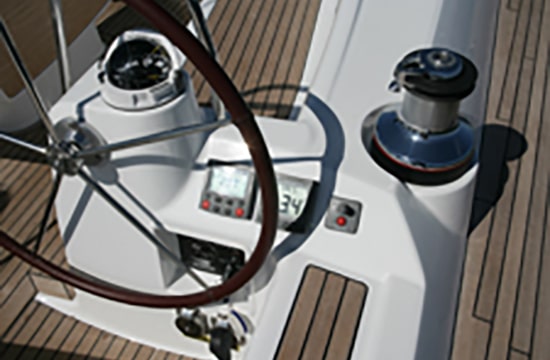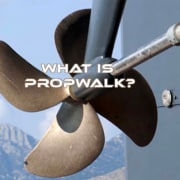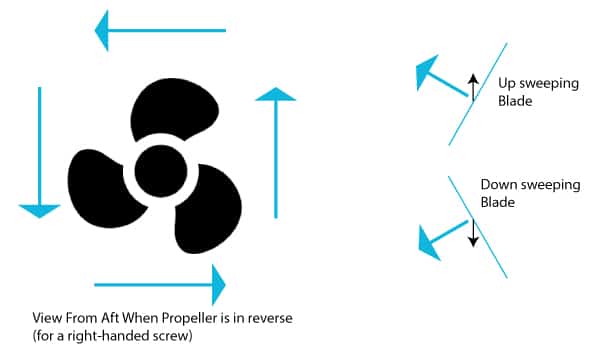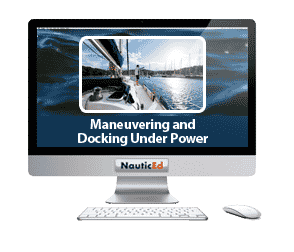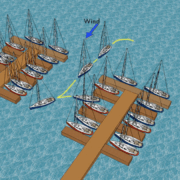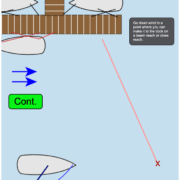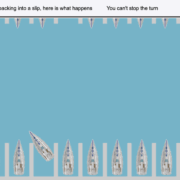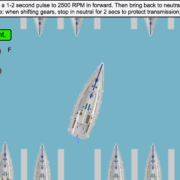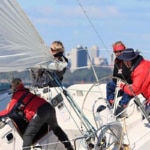What is Propwalk on a Sailboat?
The information contained in this explanation of what is propeller-walk (aka “propwalk”) comes directly from the NauticEd Maneuvering and Docking a Sailboat Under Power sailing course which forms part of the requirement for the NauticEd Sailing Certification ranks of Skipper, Bareboat Charter Master, and Offshore Captain.
You’ve learned to sail, sailed for a few years, and now you’ve upgraded to a bigger boat with an inboard engine. How frustrating! You want your new sailboat to go backward but you keep going sideways. Welcome to propwalk. GRRRRR. This is not something that you probably got taught at your local sailing school because you learned on a smaller boat with maybe an outboard. Now you’ve got a much bigger and heavier boat and there are more expensive mistakes that can be made. Propwalk can be frustrating or you can understand it and use it to your advantage.
What is Propwalk?
Propwalk is when two phenomena working together.
1. The First Phenomenon is the “P” factor.
In single-engine propeller-driven airplanes, just as the pilot pulls back on the stick on takeoff after the plane has attained flying speed, the plane tends to yaw sideways and the pilot must counter with the tail fin rudder. The same yaw effect happens in a sailboat.
To explain, imagine you’re walking up a spiral staircase. Each step is the same height and requires the same amount of energy to go up the next step.
Now imagine if the spiral staircase was tilted over 20 degrees. You’d find that as you went around the stairs they would be steeper on one side and flatter on the other. Or the stepper side cuts through more vertical space than the flatter side.
As we look at a propeller and the water flowing through it, the arc that the tips of the propeller follow relative to the moving water pushed by the propeller is a spiral shape, much like a spiral staircase.
Or another way to see it, is to observe the sweep of each blade as it passes through the water.
Now if we tilt the shaft of the propeller down, the spiral also tilts down.
But we have to put put a few prefaces on this. There must be no boat hull above to affect the initial flow of water, the water must be deep and the propeller can not be moving horizontally through the water – that’s a lot of prefaces and not reality. But here is what that would look like anyway.
Now let’s put the propeller in close proximity to the hull of the boat where the water tends to move horizontally. This is represented here by the imaginary sweep lines. Here then you can see that the up-swinging reversing blade (green -starboard) cuts more of the flowing water similar to the tilting staircase example above.
In much the same way as the tilting staircase, the down-sweeping blade cuts through less flowing water than the up-sweeping blade. This creates more force on the up-swinging side of the propeller than the down-swinging side and thus a torque is produced on the prop shaft.
This results in the following forces and thus a resultant clockwise torque on the boat.
In a similar fashion, imagine yourself treading water in a swimming pool and your right arm swings in big circles while your left swings in smaller circles. Your body would move backward but the action would also turn your face to the right and consequently your back to the left. The boat turns in exactly the same way.
In forward gear, the exact same phenomenon occurs, just in the opposite direction. However, we notice it much less because the water from the propeller is being pushed over the rudder which creates far greater forces and thus counteracts any tilt-induced torque.
So in summary, a boat that has a counter-rotating shaft, when in reverse, yaws clockwise (stern to the left) because the shaft is tilting downwards. Factors to reduce the effect include having a smaller diameter propeller or reducing the pitch (twist) of the blade or lengthening the shaft so that the water flow is further from the boat which would tend to allow the water flow to be more in line with the shaft. The effect is also reduced by a slower turning propeller IE less engine RPM.
An alternative way of mounting the propeller is called a saildrive and these are widely accepted in Europe. Saildrive systems have a horizontally mounted propeller shaft and therefore they do not create prop walk.
But there is no need to run out and go to the expense of converting your boat to a saildrive unit if you are experiencing frustration with prop walk. Because even with a sail drive the second phenomenon applies.
2. The Second Phenomenon is the Wash-Lift Effect
The wash-lift effect has been documented heavily by Dave Geer who is one of the worlds leading propeller engineers.
Dave wrote a white paper on the p-factor effect combined with this wash lift effect. We contacted Dave and asked him permission to make this white paper available to NauticEd students. He graciously accepted. For more in-depth reading on this, here is Dave Geer’s propwalk white paper for further interesting reading.
As the propeller turns and slices the water with its blades, it you imagine how it would push water out of the tilted blade, but not exactly directly horizontally. An upsweeping blade pushes water up as well as horizontally and a down-sweeping blade pushes water down as well as horizontally.
Similarly, the blade sweeping sideways at the top of the rotation pushes water sideways one way as well as aft. At the bottom sideways sweep of the propeller, the water is pushed in the opposite direction as well as aft. The horizontal component of the water movement creates thrust. The top and bottom sweeps sideways movements of the blades cancel each other out. The upsweep lifts water up under the hull and the down sweep sucks water down.
For a right-hand screw in reverse, water is pushed up creating a high-pressure wave on the starboard side of the hull. The water being pulled down on the port side of the hull creates a trough. The hull then slides sideways into the trough.
See the following animation, where you can see the wave forming which has an effect of a fire hose under the water pushing the hull sideways.
The wash-lift effect is present in boats with tilted shaft arrangements and sail drive arrangements. However, the propwalk effect is reduced when only operating with a saildrive. If you think about the tilted shaft effect, the upwash is greater because the blade is twisted more up on the upswing side.
The result is that tilted drive shaft boats have a much higher propwalk effect than sail drives. In many saildrive boats, you won’t notice the propwalk as much as in shaft drives.
Let’s Take a Look at Propwalk
In the NauticEd Virtual Reality Training program, you can experience a real sailboat and see how propwalk reveals itself. Here is a video that was recorded in the Virtual Reality program. We also show how you can beat propwalk in a certain common situation.
See the NauticEd Virtual Reality program here
Now You Understand
Now that you understand the theory of propwalk, all you have to do is practice the exercises in the NauticEd Maneuvering Under Power course a few times and you’ll have it licked.
You can also get the NauticEd Maneuvering Under Power hybrid paper ebook from Amazon. The paper book has QR codes embedded throughout allowing the book to come alive when you scan the QR codes with any phone. Get the book tomorrow on Prime.

